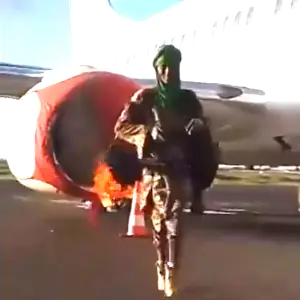(Photo from unconfirmed video showing an insurgent burning the presidential plane in Bamako. The person filming the attack speaks in Peul or Fulani language)
By Arezki Daoud: This week’s attacks on the Malian capital of Bamako highlight the junta’s difficulty in providing basic security for the country and its inability to degrade terror groups. They also signal further challenges the junta may face in the coming weeks and months. The attacks can be seen as a message to the junta, showing they are no longer out of reach, despite being protected by Russian mercenaries, many of whom were killed in these attacks.
Opposition leader Mohamed Ag Ahmedou told the North Africa Journal, “The triple terrorist attack by JNIM on the Air Force base, the National Gendarmerie Academy, and the main territorial brigade of Faladie is a strong message to Assimi Goita’s autocratic junta that Mali is falling to terrorism. Mali is descending into chaos due to the inefficiency of our Malian armed forces.”
JNIM, which has been increasing its activities both within and beyond Mali’s borders, sent a clear signal to junta chief Assimi Goita and his allies, including Wagner Group mercenaries. While the junta has largely focused on waging war against the Tuaregs in the central and northern regions, terror groups have intensified their campaign of destruction. Their main aim now appears to be targeting the Malian regime within its own capital.
Concerns are also growing about the deployment of the Malian armed forces. Mohamed Ag Ahmedou questions, “How can the country be secured if each putschist colonel has an entire battalion dedicated to his personal protection? The five colonels responsible for the 2020 and 2021 coups have entire battalions for their protection, essentially holding Mali hostage. They seem more concerned with securing their own power than the safety of the country.”
While Russia has been steady in its support of the Malian junta, the deaths of many Russians this week, combined with the disastrous outcome of the Tinzouaten clash that saw dozens of Russian casualties, have reportedly raised concerns in Moscow. The situation in Mali is beginning to look unwinnable for Russia, echoing its past experience in northern Mozambique, where Wagner Group suffered an embarrassing defeat and was forced to withdraw. A similar scenario may now be unfolding in Mali.
———–
More on Mali:
By MondAfrique: A commando from the Group for the Support of Islam and Muslims (GSIM or JNIM), which oversees various jihadist groups affiliated with Al-Qaeda in the Sahel, attacked Bamako airport and the gendarmerie school in the Faladjé district on the morning of Tuesday, September 17. The Malian armed forces regained control of both sites.
According to numerous security and civilian sources contacted by RFI, the death toll could be much higher: at least 30 gendarmes and soldiers killed, likely more. The numbers vary depending on the source, with reports of dozens of wounded arriving at hospitals in the capital.
In its propaganda messages, JNIM claims “around a hundred” killed or wounded and states it inflicted “heavy losses on Wagner mercenaries.” “We don’t yet know the exact number, but it’s overwhelming,” a Malian security source angrily explained.
The precise number of casualties on both sides is still unclear. This attack follows repeated threats from JNIM against the three capitals of the Sahel States Alliance.
In one of the videos filmed at the deserted airport, a jihadist in fatigues, wearing a green turban, is seen setting fire to the engine of the presidential plane. The VIP lounge was also targeted, and several aircraft were damaged, according to various sources, including a UN plane.
At the gendarmerie school, cadets were reportedly caught in their sleep, with another video showing several charred bodies near beds, still dressed in their sports gear.
Malian Army Response
Malian army chief of staff General Oumar Diarra appeared on television from the gendarmerie school to announce that “the infiltrating terrorists had been neutralized, and their accomplices were being sought.” He appeared with a group of around 20 civilians, presumed jihadists, tied up on the ground, blindfolded.
The junta’s response has not been particularly original. General Diarra referred to a “somewhat complex infiltration attempt” and stated that the “situation was under control.” He addressed the Malian population, saying, “the situation was intentional.” He urged the public to cooperate with defense forces, but to “avoid confusion.” He added, “The goal of these terrorists is to turn us against each other and try to stigmatize people here and there.”
Earlier, in a communiqué, the Ministry of Security and Civil Protection had called for “the vigilance and patriotism of the population, urging them to report any suspicious movement or noteworthy activity to the defense and security forces.” Throughout the day, several attacks against civilians wearing Salafist religious symbols or dressed in Fulani and Tuareg nomadic styles were reported in the capital, reviving memories of the anti-Tuareg violence of 2012 during the northern rebellion. Some sources even reported lynchings.
JNIM’s Claim of Responsibility
Led by Iyad Ag Ghaly, once the number one enemy of the French army in Mali, JNIM quickly claimed responsibility for the Bamako attack. A communiqué stated that “the mujahideen had taken full control of Modibo Keita military airport, inflicting heavy losses on Wagner mercenaries and destroying several planes and vehicles.” In a video released several days before the attack, a jihadist fighter directly threatened Colonel Assimi Goïta with an uncovered face.
According to a source from Mondafrique, nearly 400 men from the Malian katibas Macina and Sarma, as well as the Burkinabé sister katiba Ansaroul Islam, have been recruited and trained since February by Mauritanian Abu Hamza Chinghetti near Timbuktu, particularly in the use of suicide vehicles. This move by JNIM aims to respond to the military alliance displayed by the armies of the three Sahel States Alliance countries, whose founding anniversary was celebrated on Tuesday. Colonel Assimi Goïta is currently the president of the AES, and Bamako was specifically chosen as a target.
Previous Attacks in January
In January 2024, an Islamist armed group linked to Al-Qaeda killed at least 32 civilians, including three children, and burned over 350 homes in central Mali, forcing around 2,000 villagers to flee. Human Rights Watch documented the attack on the villages of Ogota and Ouémbé in the Mopti region on January 27. These attacks occurred amid a cycle of retaliatory killings and communal violence in central Mali. “Islamist armed groups and ethnic militias brutally attack civilians with impunity,” said Ilaria Allegrozzi, senior Sahel researcher at Human Rights Watch. “The authorities should act to end the deadly cycles of revenge killings and violence and better protect civilians under threat.”
A Network of Disparate Groups
Much like the Taliban’s victory in Afghanistan, achieved through their knowledge of the terrain and territorial networks, JNIM unites a range of disparate groups: Ansar Dine, created in 2012 by Iyad Ag Ghali to rally parts of the Tuareg community, Amadou Koufa’s Katiba Macina, based in central Mali, Katiba Serma near the eponymous forest, also in central Mali, and Katiba Gourma in the tri-border area between Burkina Faso, Mali, and Niger.
By federating multiple structures, but especially through its broad ethnic base, open to Arab, Tuareg, Fulani, or Bambara populations, JNIM claims a Malian national identity comparable to the dynamic created by the Taliban through their alliances with Afghan tribal structures.
Like the Taliban, JNIM has adopted a similar organizational structure: A council of leaders, the Majilis-Al-Ayan, is at the top, assisted by a general popular assembly, the Majilis-Al-Shoura. Unlike the Islamic State in the Greater Sahara (ISGS), JNIM does not have a “guru” figure but a “responsible delegate” leader. Iyad Ag Ghali is simply the “Mullah” of GSIM, comparable to Mullah Omar, the leader of the Taliban from 1994 until his death in 2013.
Targeted by the Junta
In November 2023, Mali’s judiciary announced the opening of an investigation into several ethnic separatists and leaders of armed groups linked to Al-Qaeda, including Iyad Ag Ghali, for terrorism and money laundering. He remains at large.
Human Rights Watch has detailed the widespread abuses committed by Ansar Dine against civilians in northern Mali, including executions, beatings, floggings, and arbitrary arrests of people accused of haram (forbidden) behavior, such as smoking, listening to music, or neglecting daily prayers. An Islamic police force, Hisbah, meted out punishments for these “offenses,” often after summary trials. By MondAfrique








